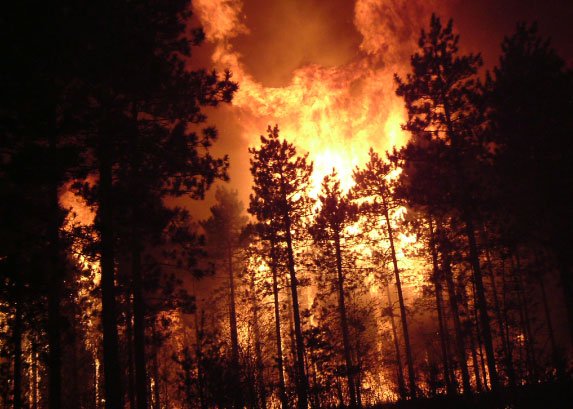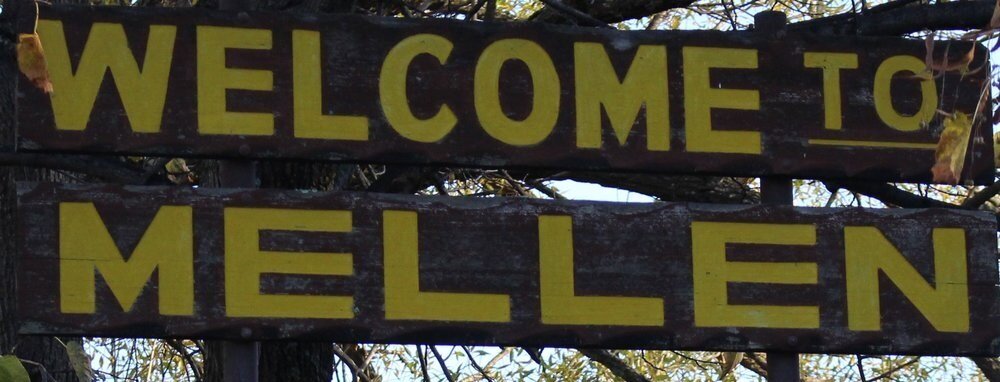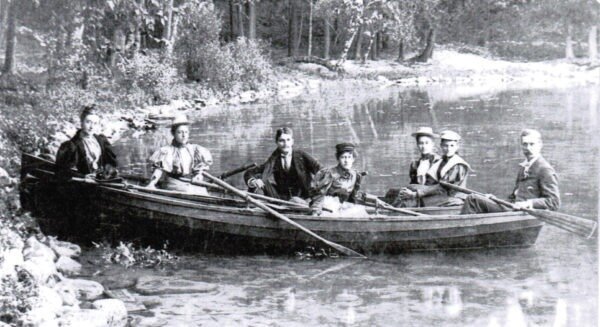Cryptid Profile: Bozho - The Monster of Lake Mendota
Lake Mendota, the 9,781-acre picturesque lake which sits alongside the University of Wisconsin-Madison. Known as the largest of four lakes in Madison, as well as the most studied lake in the United States, Lake Mendota has been a social gathering spot for locals since the city was founded in 1829. Fed by the Yahara River, the lake sports a max depth of 83ft, 21 miles of shoreline which contains five beaches, and fish species which include Sturgeon, Musky, and Northern Pike. But what many outside of Wisconsin don’t know, is that at one point, a monster was said to also call Lake Mendota home.
Bohzo, whose name is a shortened version of either the Potawatomi word “Manabozho” or the Algonquin word “Winnebozho”, was first reported in the late 1860’s by a couple canoeing out on the lake. As they made their way to Governor’s Island, the couple accidentally hit what they thought was a log with one of the oars. After being struck, the “log” began to thrash a bit in the water before sinking back down below the surface. The couple quickly headed back to shore and later wrote of their encounter, “We were not too long in deciding that retreat was the better part of valor and we resolved to say nothing about the matter.”
While silence seemed the best course of action for the first witnesses, Bozho was not one to just sit around and let its presence go unnoticed, so it showed up again nearly 20 years later on June 27th, 1883. This second encounter with Bozho would not be as calm as the one which preceded it though, and the fear which was put into the witnesses who were there that day would never be forgotten.
While out in their boat enjoying the water, a married couple known from reports as Mr. & Mrs. Dunn encountered what could only be described as gigantic, 25ft greenish black snake. As the pair made their way across the water, the creature appeared from below the surface and began to follow them. Taking notice of what was approaching, Mr. Dunn began to row faster, but the snakelike creature was swimming too fast for them to safely get away. Suddenly, the beast hit the side of the boat and tried to slither its way in. Panicked, the couple started to beat the creature with their oars in hopes of keeping it out of the boat, but the monster was relentless. Not knowing what else to do, Mr. Dunn picked up a hatchet that was kept in the boat and hit the beast in the head and body. The creature finally stopped trying to enter the boat and slid back down into the water. Trembling, Mr. Dunn picked up the oars and rowed back to shore, all while his wife kept an eye on the water around them in case the monster decided to return.
Bozho, possibly recovering from the wounds given to it by the Dunn’s, would keep to itself and not be seen again until the 1890’s. These sightings would all be reported by multiple people and none of them would be as extreme as the one in 1883.
In 1892, multiple witnesses both onshore and in the water reported seeing a large creature that resembled a snake undulating through the water. The lake monster was often seen moving in a direction towards Esther Beach and would be sighted for a few minutes at a time. Bozho would break the surface, glide forward with a majority of its body exposed in a hump-like formation, and would then dive back down under the water. In 1897, a man by the name of Eugene Heath vowed to catch the serpent in the lake after it was reported that a large number of dogs were being swallowed alive while swimming in the water. Like most monster hunts though, his was unsuccessful. Two years later, in 1899, two women would report coming face to face with Bozho accidentally. This would lead to one of two of the more humorous reports of the serpent on record.
As the pair were making their way to shore, the creature quickly surfaced in front of their boat. The women, who were understandably frightened, screamed at the sight of the large snake-like head rising before them. Bozho, also apparently frightened at the boat directly beside it, quickly thrashed around and dove back down in a hurry. The commotion caused a great deal of foam to rise up from the water and nearly knocked the boat over in the process.
Sightings of Bozho from a distance would continue on for years as usual, but the first piece of physical evidence that something unknown was living in the lake came in 1917. One day while out walking alongside the lake near Picnic Point, a university student came across a large unknown scale that had washed up on shore. Intrigued by the sheer size and thickness of the scale, the student brought it to one of the professors at UW Madison for study. After being tested for quite some time, the scale was officially unable to be identified. The closest anyone could tell was that this scale was from a Sea Serpent and must have come from Bozho. Like most cryptozoological evidence though, this scale has been lost and only the story of the discovery lives on.
That same year, two more sightings would occur. One would be classified as a now standard run-in with Bozho, while the other would be remembered as the most memorable and humorous encounter to date. The first encounter involved a local fisherman who was fishing in the same vicinity where the scale was found. The man claimed that as he was casting his rod off the end of Picnic Point, a large snake-like monster with blackish green scales and huge jaws rose up out of the water not more than 100ft away from where he stood. The man, paralyzed by fear, watched as Bozho silently moved through the water, eventually turning in his general direction. After staring for a few minutes, the man fled in fear, leaving all his fishing gear along Picnic Point.
The second encounter, which is frequently talked about in Madison, involved a college couple, a dock, and the tongue of a serpent. While out sunbathing on a dock behind a frat house one day, a young couple decided they wanted to hang their feet in the water while soaking up the sun. It is reported that the pair positioned themselves on their stomachs with the boyfriends head turned one way, and the girlfriends turned the other. As they laid in silence, the girl began to slowly bob her feet up and down in the water. Laying with her eyes closed, she soon heard a splash in the water and figured it was her boyfriend jumping into the lake. Continuing to move her feet, she suddenly felt something tickling the bottom of them. Surprised, the girl pulled her feet up and asked her boyfriend to stop. As she lowered them once more into the water, they were quickly being tickled yet again. Now annoyed, the girl raised up to yell at her boyfriend only to find him asleep on the dock beside her. The young woman instantly pulled her feet up out of the water and looked behind her. There in front of her, rising up out of the water, was Bozho. Its long tongue was slipping in and out of its mouth as its head and neck moved side to side. Terrified, the young lady woke her boyfriend and the pair ran back to the frat house faster than they had ever run before. Bohzo continued to watch before slinking back down into the depths of Lake Mendota.
Sightings of Bozho would continue on well into the 1940’s, but they would never be as up close and personal as the ones that took place in the early 1900’s. Eventually, they would start to thin out and soon they would end altogether. Some still claimed that even though the creature wasn’t being physically seen anymore, it was still in the lake. Boats and canoes would frequently be flipped while out on the lake and strange churning and bubbles could often be seen moving through the water. While some shouted monster at these occasions, others believed the cause was nothing more than inexperienced boaters out on the lake or large sturgeons swimming along the surface.
So what happened to Bozho, did the lake monster move on through the Yahara River to a new home? Or did it possible die of old age? Nobody can truly say for certain. But whatever the case though, there doesn’t appear to be anything out of the ordinary currently living in Lake Mendota. Remember, a lake doesn’t receive the title of ‘Most Studied Lake in the United States’ without documenting anything and everything that lives within it. Besides, when a lake has a remote sensor buoy in it that monitors the impact of all natural and anthropogenic influences within for the Global Lake Ecological Observatory Network (GLEON), it would be a little hard for a monster to stay hidden.
Oh yeah, one more thing, you want to know what that GLEON buoy is named? David Buoy.
-The Pine Barrens Institute
*Image Credit: http://blog.biodiversitylibrary.org/2014/10/the-quest-for-sea-serpent-oarfish-or.html
Do you have a strange tale, family legend, or odd sighting you would like to report? Get in touch with us here to share what you know!
Want more strange stories in your life? If the answer is yes, then make sure to check out our books ‘Monsters In Print: A Collection Of Curious Creatures Known Mostly From Newspapers’ and ‘Ghosts In Print: An Assemblage of Spirits, Spooks, and Specters From Newspapers of Old’, both available from Amazon!
Make sure to also check out our shop for official PBI shirts, totes, buttons, and stickers!































